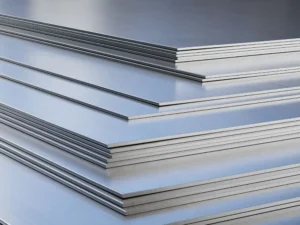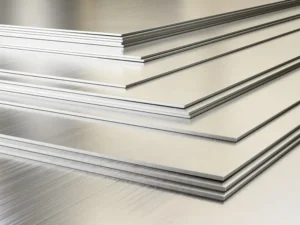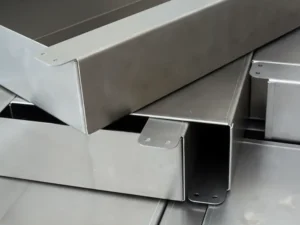Lorsque l'on parle de métaux, on doit avoir entendu parler de tôles et de plaques. Beaucoup d'entre nous pensent qu'il s'agit de la même chose. Nous nous trompons en les considérant comme une seule et même chose, alors qu'il s'agit de deux mondes différents. Il existe de nombreuses différences entre les tôles et les plaques.
Vous travaillez dans l'industrie manufacturière ? Vous utiliserez les deux. Il est donc essentiel de comprendre leurs différences. Si vous ne les comprenez pas, vous finirez par choisir la mauvaise solution pour votre projet spécifique. Toutefois, ce guide va démystifier toutes les différences. Alors, restez dans les parages !
Aperçu des tôles et plaques métalliques

Les tôles et les plaques se distinguent par leur épaisseur. Les plaques ont généralement une épaisseur supérieure à 6 mm. En revanche, l'épaisseur de la tôle varie entre 0,5 et 6 mm. Son épaisseur est toujours inférieure à 6 mm. En outre, leurs processus de production varient également.
Les tôles et les plaques métalliques ont toutes deux une importance distincte dans les différents secteurs d'activité. Par exemple, les plaques métalliques conviennent généralement à l'industrie de la construction. La raison en est que leur épaisseur est plus élevée et qu'elles peuvent supporter les contraintes. En revanche, les tôles sont idéales pour l'industrie automobile.
Les constructeurs les utilisent pour fabriquer la carrosserie et le toit de la voiture. Elles sont généralement moins robustes que les plaques métalliques. Ces tôles peuvent être fabriquées dans différents matériaux. Il s'agit notamment de l'aluminium, de l'acier inoxydable, etc. Cela signifie que vous disposez d'une grande variété de matériaux lorsque vous choisissez des plaques et des tôles.
Conseil rapide : Les fabricants utilisent les pouces comme unité de mesure de l'épaisseur des plaques métalliques. En revanche, ils utilisent les jauges comme unité de mesure de l'épaisseur des tôles. Leurs épaisseurs sont sensiblement différentes, ce qui leur confère des propriétés et des utilisations différentes.
Tôle et plaque : Principales différences
Comme je l'ai dit plus haut, il est très important pour tout projet de connaître la différence entre les tôles et les plaques. Si vous comprenez les différences, vous serez alors en mesure de les utiliser correctement. Pour vous aider, essayons de comprendre les principales différences.
1- Processus de production
La principale différence entre le métal et la tôle réside dans leur processus de fabrication. Les deux subissent un processus de chauffage, mais leur processus de laminage varie. Les tôles sont généralement laminées à froid, ce qui signifie qu'elles passent sous une série de rouleaux et que la température reste basse.
D'autre part, la production de tôles implique également une série de rouleaux. Mais le processus implique un laminage à très haute température. En outre, les plaques métalliques subissent un traitement supplémentaire. Ces traitements confèrent aux plaques une stabilité et une résistance accrues.
En termes simples, la fabrication de tôles consiste à maintenir la température en dessous du point de cristallisation. Ce processus rend les tôles malléables et faciles à plier. En revanche, pour les plaques métalliques, la chaleur est supérieure au point de cristallisation. Ces températures élevées et basses leur confèrent des propriétés différentes.
2- Intégrité structurelle

En raison de la différence d'épaisseur, les tôles et les plaques métalliques ont une intégrité structurelle différente. Une épaisseur moindre signifie une structure plus faible. Il est donc évident que les tôles n'ont pas une structure solide, mais elles sont flexibles, malléables et pliables.
Si votre projet exige une structure très flexible, les tôles sont recommandées. À l'inverse, les plaques métalliques ont une structure solide en raison de leur épaisseur. Cette structure leur permet de résister à des conditions extrêmes sans se déformer. Elles offrent une durabilité à long terme, ce qui est exigé pour les projets ultra-critiques.
3- La polyvalence
Grâce à leur propriété de cintrage, les tôles sont incroyablement polyvalentes. Elles peuvent être transformées en différentes formes sans se casser. Les architectes profitent de la polyvalence de ces tôles pour l'aspect esthétique de leurs œuvres. Par ailleurs, les fabricants utilisent les tôles pour fabriquer des pièces.
Cependant, les plaques métalliques sont moins polyvalentes en raison de leur épaisseur et de leur robustesse accrues. Cela ne signifie pas pour autant qu'elles perdent leur importance en raison de leur manque de polyvalence. Leur champ d'application est important dans les secteurs de la construction qui ne demandent pas de polyvalence. En effet, les plaques métalliques ne peuvent pas être remodelées, mais elles peuvent être soudées si nécessaire.
4- Fabrication et traitement

En général, les métaux de faible épaisseur sont faciles à fabriquer. Les tôles sont donc faciles à traiter car elles sont minces et pliables. Leur laminage s'effectue à température ambiante, ce qui réduit les efforts à fournir. De plus, leur fabrication nécessite des équipements simples.
En revanche, le traitement des plaques métalliques n'est pas très simple. Les fabricants doivent utiliser des outils puissants pour découper et traiter ces plaques. Il s'agit notamment du découpage au plasma, de l'usinage CNC et du jet d'eau, qui sont utilisés pour la fabrication. Une chose que je voudrais mentionner est l'impact de leur matériau de fabrication sur leur fabrication.
Rappelons qu'un tôle en acier inoxydable serait solide. Ce matériau puissant (acier inoxydable) rend la tôle solide et légèrement difficile à couper. Il en va de même pour plaques en acier inoxydable. Toutefois, leur coupe et leur traitement sont plus faciles si leur matériau est plus faible.
5- Poids et maniabilité
Les tôles métalliques sont avantageuses à manipuler en raison de leur légèreté. Vous pouvez les utiliser et les installer facilement. Elles sont faciles à plier avec des outils standard et peuvent être transportées vers les sites de fabrication. De plus, cette facilité de manipulation augmente la rapidité de vos projets. C'est l'une des raisons de sa popularité.
En revanche, les plaques métalliques sont beaucoup plus lourdes. Ce n'est pas une mauvaise chose, car ce poids confère à la plaque une plus grande solidité. Toutefois, cette solidité élevée a une contrepartie. En raison de leur poids élevé, leur manipulation peut s'avérer difficile. De plus, leur transport d'un endroit à l'autre est également fastidieux.
6- Applications et utilisations
Les tôles sont largement utilisées dans les automobiles. La légèreté de leur moteur leur permet de fonctionner en douceur. En outre, elles sont couramment utilisées pour la fabrication des carrosseries et des toits. Leur flexibilité est utilisée pour la formation de pièces de décoration. L'industrie aérospatiale utilise également ces tôles.
D'autre part, les plaques métalliques sont utilisées pour fabriquer des pièces et des composants résistants. Les sociétés gazières et pétrolières les utilisent également pour former des réservoirs. Les projets de construction de ponts ne négligent jamais leur utilisation. Cependant, leur utilisation est courante dans l'industrie de la construction pour réaliser des structures solides.
7- Coût et accessibilité
Le coût des tôles et des plaques métalliques dépend de plusieurs facteurs. Les tôles sont généralement moins chères que les plaques. Permettez-moi de vous en donner la raison. Leur processus de production est relativement plus simple. Les plaques métalliques sont plus coûteuses, car elles subissent un traitement supplémentaire pour assurer leur résistance.
L'épaisseur est un autre facteur qui influe sur leur coût. Une augmentation de l'épaisseur nécessite davantage de matières premières. Une plaque de métal de 20 mm d'épaisseur coûte plus du double d'une plaque de 10 mm du même matériau. Il en va de même pour les tôles. Toutefois, les tôles sont toujours moins chères que les plaques.
Lequel choisir : Une plaque ou une tôle ?
Le choix entre les tôles et les plaques métalliques dépend de vos besoins et de vos préférences. Les plaques métalliques conviennent lorsque vous avez besoin de solidité et de durabilité. En revanche, les tôles sont idéales si vous avez besoin de flexibilité. Les deux offrent des propriétés uniques.
N'oubliez pas que le prix des tôles et des plaques métalliques peut influencer leur choix. Les tôles sont moins chères. Si vous souhaitez réduire le coût de votre projet, vous pouvez opter pour les tôles. Si vous êtes ingénieur et que vous travaillez sur un projet de construction, je vous recommande vivement de choisir des plaques.
La raison en est que ces plaques sont solides et capables de supporter le poids et les contraintes. Vous travaillez dans l'industrie automobile ? Vous devriez opter pour des tôles. En effet, leur faible poids permet de fabriquer des pièces moins lourdes. En conséquence, le rendement énergétique du Chili s'est amélioré. Vous voulez savoir lequel est le meilleur ?
Les deux sont excellents et offrent des propriétés uniques. Si vous choisissez une tôle pour la construction, vous serez désemparé. De même, choisir des tôles pour l'industrie automobile n'est pas une bonne idée. Veillez donc à les sélectionner en fonction de leurs propriétés. Leurs performances vous impressionneront si vous les choisissez en tenant compte de leurs forces et de leurs faiblesses.
Questions fréquemment posées
Qu'est-ce qui est le plus léger : les tôles ou les plaques ?
Les tôles sont plus légères que les plaques. Leur épaisseur varie entre 0,5 mm et 6 mm. Les plaques métalliques sont très épaisses, ce qui augmente leur poids.
Les tôles peuvent-elles être utilisées pour des applications lourdes ?
Non, les tôles ne sont pas adaptées aux charges lourdes. Elles sont légères et ne peuvent pas supporter des applications aussi lourdes.
Quel est le meilleur matériau pour le soutien structurel ?
Les plaques métalliques sont préférées pour le soutien structurel en raison de leur durabilité et de leur résistance extrême. Leur épaisseur plus élevée améliore également leur support structurel. C'est pourquoi les fabricants les utilisent dans l'industrie de la construction.
L'acier inoxydable est-il utilisé à la fois pour les tôles et les plaques ?
Oui, l'acier inoxydable est utilisé à la fois pour les tôles et les plaques. L'acier inoxydable leur confère une résistance accrue à la corrosion.
Conclusion
Il est essentiel de connaître les principales différences entre les tôles et les plaques métalliques. Ignorer cette différence peut avoir un impact sur votre processus de fabrication. Les erreurs de sélection vous feront perdre du temps et de l'argent et vous causeront des maux de tête. C'est pourquoi j'ai mentionné tout ce qui concerne les tôles et les plaques.
En résumé, les feuilles de métal sont minces, flexibles, pliables et peu coûteuses. En revanche, les plaques métalliques sont très chères et robustes. En raison de leur durabilité, leur prix élevé vaut la peine d'être investi. J'espère que cet article aura été le plus utile possible. En fin de compte, vous serez en mesure de prendre des décisions d'achat en connaissance de cause.
